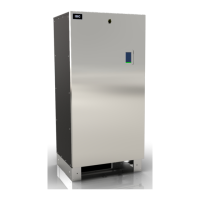Boiler Head Loss - EX 400, EX 500
Flow rate (gpm) 20 30 40 50 60 70 80 90 100
Head @ flow (ft) 2.6 3.0 3.7 4.4 5.2 6.3 7.4 8.9 10.7
Table 7 Boiler Head Loss - EX 400, EX
Boiler Head Loss - EX 700, EX 850
Flow rate (gpm) 20 30 40 50 60 70 80 90 100
Head @ flow (ft) 2.6 2.9 3.2 3.7 4.2 4.8 5.5 6.4 7.2
Table 8 Boiler Head Loss - EX 700, EX 850
Ensure that the pump is rated for the design circulating water temperatures; some pumps have a
minimum water temperature rating above the low temperature potential of the boiler. Following
installation, confirm the actual performance by measuring Δ°T (under high and low flow conditions)
after establishing the correct firing rate.
To use legacy heat, we recommend water flow after burner shutdown. There can be significant
build-up of energy due to the volume of heated water in the system. Default load settings will run
the boiler’s primary pump for up to 5 minutes (300 seconds) after burner shutdown. Secondary
pumps can be set to run up to 15 minutes after burner shutdown (for the last calling load). As
shipped, the default settings will run the Load pump for 5 minutes to place the legacy heat where it
is useful. Any secondary pump can be set to run for 0 – 900 seconds in the heat purge mode. Guard
against deadheading pumps when all zone valves are closed by setting the load Pump Post Purge
(sec) to '0'.
The primary pump must be under the control of the boiler to allow pump purge after burner shut-
down.
Installers must conform to the piping design configurations provided to simplify the control
application, promote good loads and flow management.
Propylene glycol usage
Warning
Do not use automotive-type ethylene or other types of automotive glycol antifreeze, or
undiluted antifreeze of any kind. This may result in severe boiler damage. Installers
must ensure that glycol solutions are formulated to inhibit corrosion in hydronic heating
systems of mixed materials. Improper mixtures and chemical additives may cause
damage to ferrous and non-ferrous components as well as non-metallic, wetted
components, normally found in hydronic systems. Ethylene glycol is toxic, and may be
prohibited for use by codes applicable to your installation location. For environmental
and toxicity reasons, IBC recommends only using non-toxic propylene glycol.

